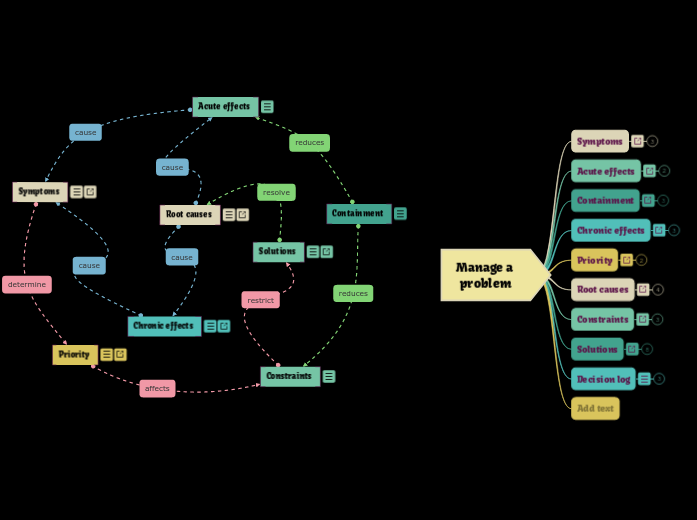Manage a problem
Symptoms
Acute effects
Containment
Chronic effects
Priority
Root causes
Constraints
Solutions
Decision log
Events, notifications, decisions and actions taken
Add text
Symptoms
The symptoms of a problem are the external signs that something is wrong.Symptoms may appear early or late, and may seem unrelated to the real problem. Sometimes they can send you in the wrong direction. When something has gone wrong, it can be hard to separate out the symptoms of the real cause from other things that are happening by coincidence, or due to a different cause.When you finally discover the root cause, you should be able to explain all symptoms. If you can't explain all of the symptoms, then the root cause might not be the only cause, there may be more than one issue, or the "symptom" may have been unrelated from the outset.Symptoms are a measurement of the problem. You might need to look for or measure new symptoms to check whether you are solving the problem or making it worse.
lRoot causes
The root causes are the real reasons behind the problem.They cause both the acute and chronic effects of the problem, which may be very different to each other and to its symptoms.The process for finding the root cause of a problem depends on what kind of problem it is - complicated or complex.A complicated problem can be analysed logically to discover the root cause. For example, you can eventually trace the broken part of a machine to get it working again, or find the error in a spreadsheet that has thrown out all the figures.A complex problem is one that arises from the interaction of many other causes, and cannot be logically analysed. For example, economic problems have many causes and dependencies, and there is no single broken part to fix. One approach is to test your understanding by making small changes and measuring improvements.The root causes are where you target your solution, not on the effects or symptoms.
lSolutions
Solutions are changes that address the root cause and thereby reduce the effects.A lot is written about creativity and lateral thinking to help generate solutions, but there is no substitute for a good understanding of root causes as a starting point for creative solutions.You might have a range of options, some better than others and some more expensive than others.All solutions will be influenced by constraints. If they don't meet the constraints, then they are likely to be rejected without trying.You must be able to monitor and measure result of a solution. This might mean defining more symptoms and monitoring the situation over a period of time.
lAcute effects
The acute effects of a problem can happen quickly and unexpectedly, causing sudden symptoms. Acute problems usually need to be addressed quickly. Sometimes they need to be contained to stop the effects spreading before they can be fixed.
Priority
The priority of a problem is a combination of its chronic and acute impacts.Often, acute problems are seen as having higher priority because their immediate cost seems high. Chronic effects are often neglected until there is "more time" to solve them, but they might cost more over a longer period.The cost of a problem influences its priority and also affects constraints. Costs are both tangible and intangible, and can include:Safety risksWasted materialsLost timeCost of reworkLost reputationLost opportunitiesIndirect impact on other issues
lConstraints
Any solution to a problem will have additional constraints, which the solution must also meet:What you can actually changeHow much time you have before a temporary workaround is no longer acceptableThe impact the solution will have in other areas and peopleConsensus, if the solution involves other areas and peopleThe cost of the solution relative to the cost of the problem: usually, solutions need to cost less than the problem they solveThe constraints will limit your options for viable solution. Reducing constraints will give you more flexibility to find a solution.
Containment
You may need to contain a problem to prevent it from getting worse or spreading.Temporarily controlling a problem is not the same as permanently solving it. Often, temporary measures address only the acute impact, and do not solve the underlying causes. They must be implemented quickly, before the root causes are found and solutions developed.To control a problem situation, you might need to do things like recalling faulty goods, suspending a service, making manual corrections or finding a short term workaround. These are not sustainable, so are not long term resolutions. Containment and workarounds are not free, but cost some disruption that is less worse than the problem.A temporary workaround does two things:It helps to reduce the acute impactIt buys you some time to resolve the underlying issue. This helps to reduce the time constraints on finding a solution.
Chronic effects
The chronic effects of a problem are the results of not resolving it, over the long term.Chronic effects often accumulate slowly and are difficult to diagnose. For example, "Low profitability" can have many causes. It is the chronic effect of many different problems.Problems with chronic effects are often tolerated because there is no time to resolve them properly. They often only get attention when they become acute, and a fix to an acute problem may not address the root cause.
l